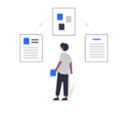Hardware has its place. Software has its place. And policies and procedures have their place. But what’s the biggest bang you get for your IT help desk buck?
It comes from investing in training.
Training is typically identified as one of the help desk’s top 10 challenges. However, when you increase your training, you increase the number and type of issues you're able to resolve during the first call. And you increase the percentage of tickets that you resolve without having to escalate.
Investing in continuous training as a help desk management best practice goes a long way. So, here are six ways to level up your help desk training.
1. Make Time for Training
Your first task when it comes to delivering training is making the time.
This is difficult because you likely feel that answering calls is your priority, not training. You may be so busy fielding support requests that you wonder where you’ll find the time to fit in any training.
This is why it’s so important that you make (don’t find, make) the time for training: Because if you don’t, agents won’t be as capable. And if agents aren’t as capable, they’ll have a harder time resolving issues in a timely manner. And if that happens … well, any time you’ve saved by not training is quickly eaten up by a lack of efficiency.
Also, make your training sessions live, either in person or via video call, to make sure agents have the opportunity to ask clarifying questions. As far as timing goes, you can never take the entire service desk down at once, of course. So, break up training into groups. (Yes, taking people off the phones to attend training will impact your real-world stats, but this hiccup is well worth it.)
2. Schedule a Training Cadence
The key thing to remember about help desk agent training is that there is no such thing as “one-and-done.” Hardware gets replaced, software gets patched, new applications get rolled out. The working environment of your users is in a constant state of flux, which means they are continually dealing with new issues.
To keep up with the constantly changing needs of your customers, you must constantly train.
Training should be a yearlong initiative, broken down by quarters and months. The cadence you land on depends on the number of agents in your help desk, the hours of coverage you provide, the rate of technological change at any given moment, and a few other variables.
The key to success with ongoing training is to plan your cadence. Know months ahead of time what is on the training schedule. Don’t let training ambush you. Plan for it. Spread it out. Develop a comfortable annual and quarterly cadence. Your agents—and your customers—will thank you for it.
3. Discover What to Train On
Some of the topics your agents need training on are obvious, such as major software updates, changes in policies and procedures, new product and service rollouts, and changes to your knowledge base. But to level up your help desk training, you must look beyond these standard and predictable areas of focus.
 Engage your customers
Engage your customers
The customers you are helping are using the system you support every day. Get them to collaborate with you, and then look for their help with training on job functions, software, systems usage, and challenges they may face. Using this approach will help translate the customers' proficiency into better-skilled agents who understand the business they support.
Examine your metrics
Run reports on your help desk metrics to find out what areas you need training on.
Examine your first call resolution rate, for example. Find the calls that you’re not resolving at the service desk, then scan through them to find areas where training will improve performance. Reach out to your customers to discover the knowledge you need to resolve these issues during the first call.
Another metric to watch is talk times. The longer they are, the more likely you are to need some remedial training. First discover what’s causing the longer-than-acceptable talk times, then create the training to address the issue.
 The key to success is to tie training to a measurable goal. Pick a KPI, create a goal for that KPI (increasing first call resolution by 5%, for example), pick a date for reaching that goal, and then deliver the training your agents need to reach that goal.
The key to success is to tie training to a measurable goal. Pick a KPI, create a goal for that KPI (increasing first call resolution by 5%, for example), pick a date for reaching that goal, and then deliver the training your agents need to reach that goal.
 Examine your knowledgebase
Examine your knowledgebase
With new training there should be new documentation, and with new documentation there should be new training.
Find out what your agents need training on by searching for new additions to your knowledge base. Find the latest documentation on the latest issues, and then create training that brings all your help desk agents up to speed.
4. Communicate Early and Often
You have probably discovered firsthand that one of the best ways to trip up a help desk is to spring surprises on them: To deliver adequate training, you require adequate notice.
So, if one of your divisions or departments is going to hire 2,000 people over the next few weeks, that’s something they need to warn you about.
But they might not think to.
So, if you want to avoid surprises, you must exercise the initiative. Part of your job is to ensure that your help desk communicates early and often with your entire organization, so you always know what’s coming down the road … and can ensure your help desk is trained and ready.
What does this look like in practice? Here’s what the Manager of IT Support Services for a nationally ranked pediatric hospital has to say (and these are folks who can’t have downtime):
“It’s not just a cost savings,” explains the manager of IT Support Services at the medical center. “Personally, overseeing the help desk and making sure it’s staffed 24/7 is a major undertaking. So the savings for me include the fact that it allows me to spend more time making sure that our knowledge articles are up to date and making sure that our field support team has the resources they need to do their jobs to the best of their abilities.”
5. Train the Trainer
One way to level up your help desk training is through peer training, or train-the-trainer. Identify agents that are strong in a particular area, or very familiar with a certain process, then get them to deliver your training. This is especially helpful when you don't have a lot of resources to allocate to training, or if you don’t have a dedicated trainer on staff.
A train-the-trainer initiative also gives you an opportunity to give an agent a few minutes off the phone, flex their knowledge with the rest of the staff, build rapport amongst the team. It also gives you some valuable insight into an agent’s potential career path within the organization. If they do a good job, consistently, and if their training is well received by the rest of the team, you may have found yourself a future leader.
6. Invest in Certifications
The final way to level up your help desk training is by investing in certifications. The Comptia A+ certification, for instance, is the industry standard for establishing a career in IT. Today’s CompTIA A+ certified professionals have proven that they are problem solvers. They support your core technologies from security to networking to virtualization.
Other certifications to consider are:
One of the wisest investments you can make in your help desk is in comprehensive, ongoing training. Well-trained agents deliver better customer service, resolve more tickets sooner, and enjoy their jobs more.
Make the time to train your agents and listen to your help desk agents for insights into what to train on, and you will level up your help desk in no time.
By the way, training is just one of 10 challenges facing today’s help desk. Discover the other nine. Read about the Top 10 Most Common Help Desk Challenges.



